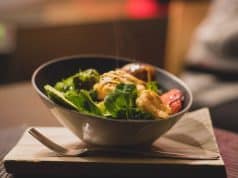The Californian family Otcaseks bought a house that had “an unusual feature”: a large, concrete-lined hole in the backyard. The only information they had about this hole it that it was a fallout shelter from the Cold War Era.
However, they weren’t told what could be down there after all these years so they didn’t know what to expect when searching the hole.
When they opened the hole they saw that there’s a rusty 15-foot ladder leading below. The ladder looked as though it hadn’t been used for decades.
At the defeat of Nazi Germany and the end of World War II, the Soviet Union and the United States were vying for control of Europe. Although the remaining Allies gave their best efforts, the Soviets were gaining more power and they were developing their own nuclear weapons.
Those nukes were very much like the ones the U.S. had used to decimate Nagasaki and Hiroshima and win the war. The mere presence of these weapons of mass destruction resulted in starting a war of posturing and propaganda which lasted throughout most of the 20th Century.
During the 20th century, many countries started building fallout shelters or underground bunkers for high-ranking government officials. If a nuclear attack occurred in one of these countries, the president, his family, and his cabinet, along with many senior army and navy officers would be ushered into these bunkers to keep them safe so that they can rebuild in the aftermath. As a result, many American civilians got the same idea and built their own shelters in case of a nuclear attack.
The Otcaseks explored the bunker and found water, canned food, clothing, and medicine, as well as paper products and books. It contained almost all the items that someone would need to survive in the event of a nuclear attack. It was even more remarkable that all the items were still wrapped in their mostly untouched vintage packaging.
The original owner of the bunker, Alvin Kaufman, was a nuclear engineer working for the U.S. Government. That’s the reason he came up with the idea of building this bunker- he decided that he wanted to protect his family from the ever-looming threat of nuclear war and thus built a safe refuge for them.
Alvin Kaufman built the shelter with enough room for a family of four. According to his daughter Debra, Alvin offered to build one giant fallout shelter for all of his neighbors to share. Sadly, he was turned down: even amidst the growing fears of an imminent nuclear attack.
Debra went od describing the shelter, saying that it contained several sleeping areas, a water tank, and an air filter that could be cranked by hand.
The Otcaseks began searching the inventory and the first item they found was an old Arrow brand Argyle sweater. Argyle, has been used to decorate everything from socks and sweaters, to robes and kilts. The Arrow brand clothing still makes shirts today but the styles have been slightly updated.
The Kaufman family also made sure to keep a great deal of cooking and preservative products. This stack of Saran Wrap, Reynolds Wrap, and plastic baggies were all perfectly designed to store food. Even ithat these products have greatly improved over the years, the vintage packaging would be worth a fairly decent amount of money in this day and age.
In the bunker there was also a container that contained all manner of long-since-expired medications from sleeping pills, medication for nausea, ointment, and an assortment of nondescript orange tablets in various bottles littered the bottom of the case.
Beside the medications, the Kaufmans also brought along a First-Aid kit that contained foot powder, bacitracin ointment, and absorbent cotton gauze. Kits of this kind were the most common feature of Cold War Era Fallout shelters and some would even contain sutures and sewing kits to be used in the event of a grievous injury from and attack or afterwards.
Some other necessities were also stocked into the shelter such as a tin of cookies sat on a shelf next to two packages of Multi-Purpose Food. California restaurateur, Clifford E. Clinton created this powdered protein mix in 1946. Clinton had reached out to his friend Dr. Henry Borsook, who was a biochemist, to develop a food substitute that would provide proper nutrition at a very affordable price.
Dr. Borsook worked on the project for about a year before he developed Multi-Purpose Food (MPF) which is a high protein food supplement that only cost three cents a meal. The affordability of MPF allowed Clinton to found the not-for-profit organization, Meals for Millions which over the following decade distributed 6.5 million pounds of MPF to relief agencies in 129 countries.
The bunker also carried some entertainment- Kaufman packed nearly a dozen issues of Analog Science Fiction and Fact Magazinein order to keep the family at least partially entertained during their potential stay in the bomb shelter.
The American Sci-Fi magazine, which was first published in 1930, was best known for publishing many stories that would become classics including stories by Isaac Asimov, Robert A. Heinlein, and John W. Campbell.
The Otcaseks also found a roll of old Kleenex paper towels which was first created in the 1920’s as a way to remove cold cream and makeup. However, the Kleenex paper towels soon branched into a number of different products, including Cottonelle, Huggies, and VIVA.
Another interesting item that was found in the shelter was a package of Dixie Paper Cups. They were first made in 1907 as a way for trains to easily serve drinks of cold water to their passengers on long drives. Originally they were called the “Health Kup”, and these small, paper cups paved the way for all that came after them.
Jars and cans of ground coffee of several different varieties were sitting ll around the room, mostly on shelves and tables and most of them had never been opened. Some of the items have been ravaged by time like the rusted one pictured here.
It seems that the Kaufmans had a love for the flavored bean and knew that if it came to nuclear war, they’d need enough to keep them sane as they waited out the fallout together.
.

A professional writer with over a decade of incessant writing skills. Her topics of interest and expertise range from health, nutrition and psychology.






















